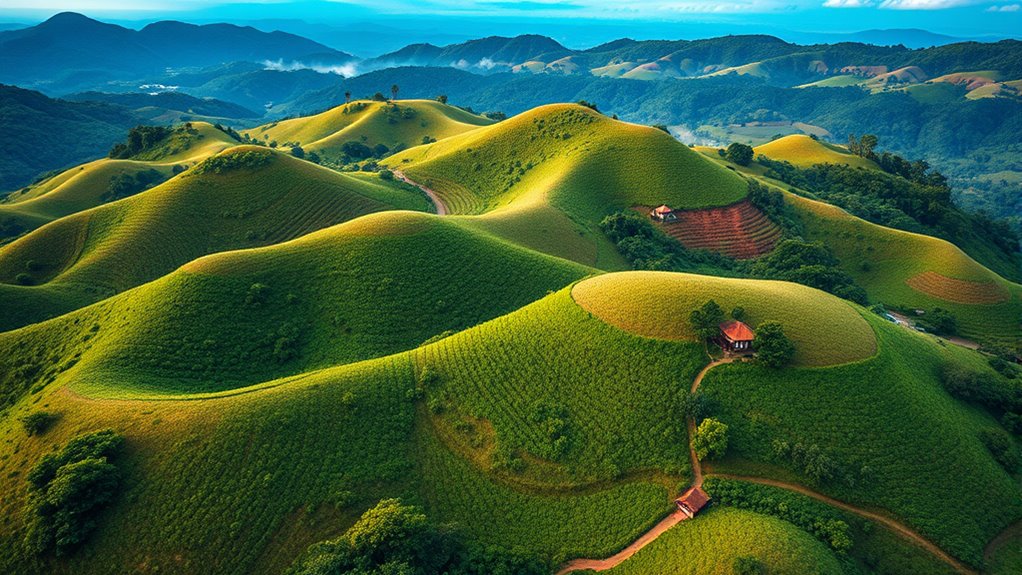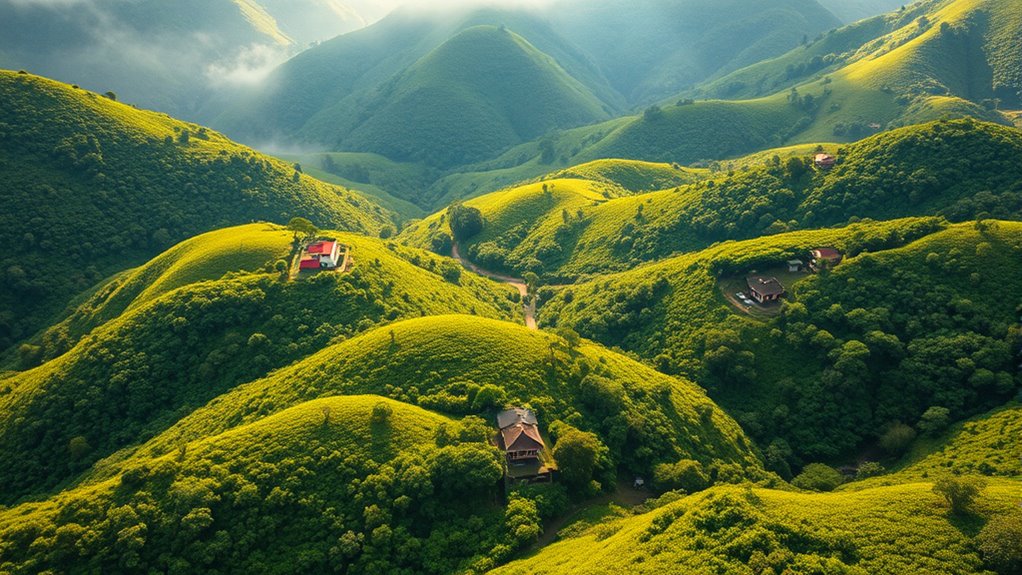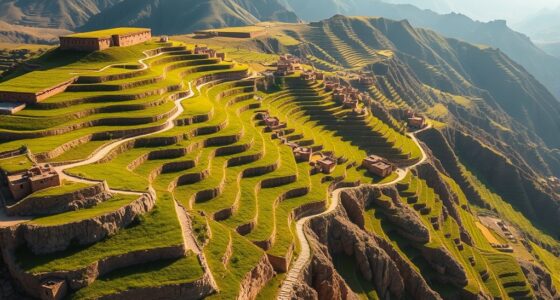The Coffee Belt covers tropical regions between the Tropics of Cancer and Capricorn, where the best coffee thrives. These areas include Central and South America, Africa, Asia, and Oceania, offering ideal climates, altitude, and soil conditions. Factors like moderate temperatures, high humidity, and distinct rainy and dry seasons shape unique flavor profiles. Higher elevations usually produce brighter, more nuanced beans. Exploring these regions reveals how climate and sustainable practices influence coffee quality — stay curious to learn more.
Key Takeaways
- The Coffee Belt spans tropical regions between the Tropics of Cancer and Capricorn, including Central and South America, Africa, Asia, and Oceania.
- Optimal coffee growth occurs at higher altitudes with moderate temperatures and high humidity within these regions.
- Latin American countries like Colombia and Brazil are known for bright, nutty coffees, while African regions produce vibrant, floral beans.
- Asian coffee regions often yield fuller-bodied, earthy flavors due to specific climate and soil conditions.
- Sustainable farming practices, such as shade-grown and organic methods, enhance coffee quality in the Coffee Belt.

Have you ever wondered why coffee grows best in certain parts of the world? The answer lies in the unique combination of climate, altitude, and soil conditions found within the so-called Coffee Belt. This belt stretches across the tropics, roughly between the Tropics of Cancer and Capricorn, and includes regions in Central and South America, Africa, Asia, and Oceania. These areas provide the ideal environment for cultivating coffee plant varieties that produce the rich, complex flavors coffee lovers cherish. The specific climate conditions—moderate temperatures, high humidity, and distinct rainy and dry seasons—allow coffee plants to thrive, especially when paired with the right elevation levels. Altitude plays a vital role, as higher elevations tend to produce beans with brighter acidity and more nuanced aromas.
In these regions, farmers often adopt sustainable farming practices that help preserve the environment while maintaining high-quality coffee production. Sustainable practices include shade-grown coffee, which involves cultivating coffee plants under the canopy of native trees. This method not only reduces the need for chemical inputs but also supports biodiversity and protects watersheds. Additionally, many farmers implement crop rotation and organic fertilization, which improve soil health and minimize environmental impact. These practices are essential for maintaining the long-term health of coffee plant varieties and ensuring that future generations can continue to enjoy premium coffee. sustainable farming practices are increasingly being adopted worldwide, emphasizing environmental conservation and quality. By prioritizing sustainability, growers are able to produce coffee with unique flavor profiles that reflect their specific terroir.
Understanding the significance of these regions and practices helps you appreciate the diversity of coffee available worldwide. Each region’s distinct combination of climate, altitude, and sustainable farming practices influences the characteristics of the coffee plant varieties grown there. For example, beans from Latin America tend to have bright acidity and nutty notes, while African coffees often feature vibrant fruitiness and floral aromas. Asian coffees might present a fuller body with earthy undertones. This diversity is a direct result of the specific conditions and cultivation techniques used in each part of the Coffee Belt. Additionally, climate conditions such as temperature and humidity are crucial factors that influence the growth and flavor development of coffee beans.
Frequently Asked Questions
How Do Altitude and Climate Affect Coffee Flavor Profiles?
Altitude effects and climate influence how coffee flavors develop. Higher altitudes typically produce beans with brighter, more complex flavors because cooler temperatures slow bean maturation, enhancing acidity and aroma. Climate factors like rainfall and sunlight also impact flavor, with ideal conditions creating a balanced profile. You can taste these differences in your cup, noticing how altitude effects and climate influence the beans’ sweetness, body, and overall richness.
What Are the Environmental Challenges Facing Coffee Belt Regions?
You might not realize it, but climate change and deforestation threaten your favorite coffee experiences. Rising temperatures shift ideal growing conditions, risking lower quality beans. Deforestation destroys essential shade trees, impacting microclimates and soil health. These environmental challenges force coffee belt regions to adapt quickly, risking the delicate balance that produces premium coffee. If unchecked, these issues could diminish your coffee choices and the global coffee economy.
Which Coffee Belt Countries Are Leading in Sustainable Practices?
You’ll find that countries like Costa Rica, Ethiopia, and Colombia lead in sustainable practices. They prioritize sustainable farming methods and often pursue eco-friendly certifications, reducing environmental impact. These nations actively implement policies that protect biodiversity and promote fair labor practices. By choosing coffee from these regions, you support eco-conscious initiatives and help guarantee long-term environmental health, making your coffee experience both enjoyable and responsible.
How Do Local Cultures Influence Coffee Production Methods?
Imagine the vibrant, diverse world of coffee, where local cultures shape each harvest. Your experience varies as you learn about coffee harvesting traditions—some regions favor hand-picking, others use machines—highlighting local skills. These practices blend with local flavor influences, creating unique profiles. You see how traditions and cultural values influence production methods, making each cup a reflection of its origins and a testament to the rich diversity that defines global coffee.
Are There Emerging Coffee Belt Regions Gaining Popularity?
You’ll notice emerging coffee belt regions gaining popularity as they experiment with unique coffee processing methods and explore diverse coffee varietals. These new areas often focus on sustainability and innovative techniques, attracting coffee enthusiasts worldwide. By embracing local traditions and blending them with modern practices, you can find distinct flavors and aromas. This growth broadens the coffee landscape, offering exciting options beyond traditional regions and enriching your coffee experience.
Conclusion
So, now you’re part of the story, wandering through the lush corridors of the Coffee Belt. Think of it as a treasure map, where each region hides a brew bursting with life and flavor, waiting for your taste buds to awaken. With every sip, you’re traveling through sun-kissed hills and shaded valleys, where coffee beans dance to nature’s rhythm. Embrace the journey—your perfect cup is just a sip away, brewed from the heart of these vibrant lands.









